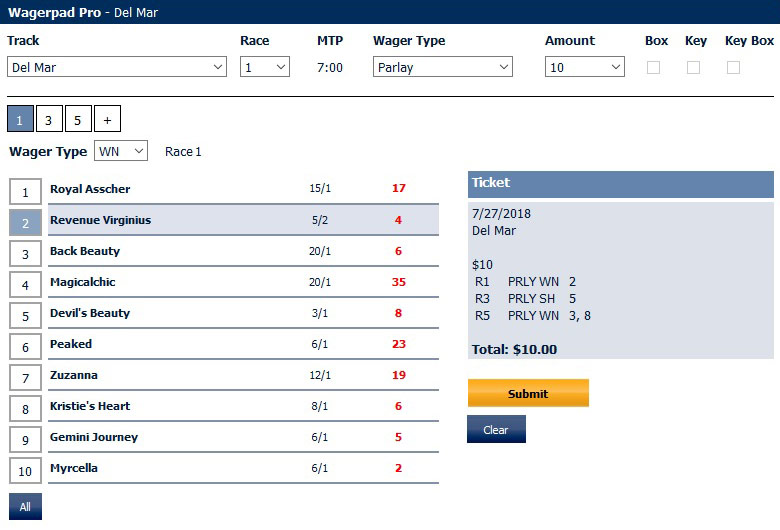Everyone makes moneyline bets without even knowing it. Even non-gamblers make moneyline bets. Betting the moneyline for a game is possibly the most simple way to wager on sports. Bettors just choose a player or team to win. If the bettor chooses the winning side, the sportsbook will pay the amount due. It’s really that simple.
- A parlay, accumulator (or acca ), combo bet or multi is a single bet that links together two or more individual wagers and is dependent on all of those wagers winning together. The benefit of the parlay is that there are much higher payoffs than placing each individual bet separately, since the difficulty of hitting all of them is much higher.
- Parlays are a wager bet that are essentially created by the bettor. He or she determines which teams to group together, and you can often group teams across different sports. The more teams you add to your parlay, the more substantial the odds become, with some bookmakers offering bonuses if you correctly predict the outcome of a 12-team parlay.
- Definition of a Parlay Bet Combine 2 or more spread, money line or total selections. Parlay wins if all selections win. Parlay loses if any selection loses.
- The definition of a parlay is a series of bets in which the money you have won is used as the stake for your next bet. If you win $10, then bet that $10; then win $20 and bet the full $30 you have won so far.
There’s no point spread with a moneyline bet. Bettors are just picking the winning side. While placing a wager is simple, trying to understand how the moneyline pays might be a bit complicated. Both sides of each moneyline wager are paid on a different schedule and that could make this kind of bet confusing.
Accumulator Bet. An accumulator, otherwise known as a parlay bet, refers to a single bet that links two or more bets/individual wagers into one whole bet. In order to win, the accumulator requires all wagers to win as they are each dependent on each other. One example could include a UFC fight night.
The favorite team or player on the moneyline is the team that’s expected to win. This side of the bet usually listed with a minus (-) sign. The underdog team or player on the moneyline is the team that’s expected to lose. This side of the moneyline is usually listed with a plus (+) sign. These signs signify how either side of the wager will pay. The minus side will pay less than original wager while the plus side will pay more than the original wager.
BETMGM SPECIAL - New Customers receive a Risk Free First Bet up to $600 + $50 Parlay Insurance for the Big Game! (Just opt-in and place a One Game Parlay wager with 4 legs or more on The Big Game and if you miss one leg, you’ll receive up to $50 back in Free bets. (Maximum 20 legs) - To Claim Click This Link
Example of a moneyline wager


Parlay Bet Definition Synonyms
Low scoring sports like baseball, soccer, and hockey are usually bet on using a moneyline. But they are also popular in football. The best way to explain how moneyline bets are paid is with an actual example. Let’s use the upcoming Super Bowl between the Kansas City Chiefs and Tampa Bay Buccaneers as an example.
The easiest way to understand moneyline wagers is by using a $100 bet. Using the above example, the moneyline on the underdog Buccaneers opened at +148 (currently ). At +148 odds, a $100 wager would pay $148 in profit if the Buccaneers won the game (for a total payout of $248). Bettors often like picking underdogs because they are usually “plus” money. This side of the moneyline bet pays out more money per unit than a wager on the favorite.
In this example, the moneyline on the favorite Chiefs opened at -176 (currently ). At -176 odds, a bettor would need to wager $176 to win $100. Since the favorite is considered the team with the better chance to win, a winning wager will usually pay out less than the original amount wagered.
Looking deeper into moneyline wagers
The two sides of each moneyline wager are essentially the opposite of each other. When wagering on the favorite it’s easiest to work from the dollar amount that will return a win of $100. When wagering on an underdog it’s easiest to understand how the moneyline pays based on how much a $100 wager will pay.
Understanding how a moneyline wager pays isn’t simple but it’s not very complicated. That said, it might take running through a few examples before fully grasping the payouts. Moneylines for football and basketball games are often tied to the point spread. When a game has a large point spread it usually has a large moneyline. Both are separate bets but are shown together in a sports wagering app screen and in a brick and mortar sportsbook.
As seen above, lines and odds may be different at various sportsbooks so consider this just an example of point spread line and a moneyline.


ALSO READ: 5 Fun Super Bowl prop bets to consider
Moneyline parlays
Parlay Bet Calculator
Moneyline parlays are growing in popularity. A parlay is a single wager that is comprised of multiple results. The payout for a parlay is greater than an individual wager on each player or game. Underdog moneyline parlays are becoming popular because the payouts can be very large. Moneyline parlays are becoming popular because of the perceived ease of choosing multiple favorites to win. Choosing one winner is difficult and multiple winners at the same time is even more difficult.
A parlay is a single bet that links together two or more individual wagers for a high payout. A 2 team parlay might pay 13/5, a three team parlay might pay 6/1, a four team parlay might pay 10/1, and so forth with the payouts getting higher with more teams or totals selected. For a single bet, 2 to 8 teams or totals can be selected.
In order for the parlay bet to win, every one of the wagers must win or push (tie). If any of the selections lose, your wager loses, regardless of the outcome or cancellation of the other games. If one or more selections is a tie, postponed, incomplete, cancelled or rescheduled for another day, then the wager reverts to the next lowest number. For example, if you place a 5 team parlay and have 4 winners and a tie, your wager pays out as a 4 team parlay. If you place a 2 team parlay and one team wins and one ties, the wager becomes a straight bet.
Parlay Bet Calculator
The resulting wager will have the same risk amount with the win being calculated to reflect the odds of the remaining team (Example: On a two team $100 parlay with team A +110 and team B -110 if A ties and B wins the resulting wager will be a straight play on B risking $100 to win $91).